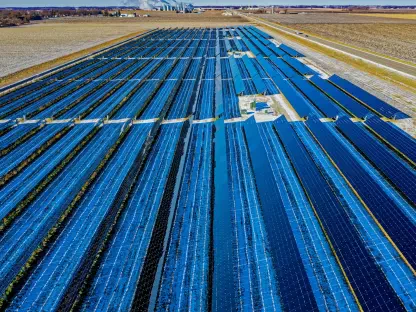As the U.S. braces for a significant surge in electricity demand, driven by the advent of data centers and the re-shoring of industries, concerns about the existing electric grid’s capacity are mounting. Considering that the grid must expand at a pace five times faster than its historical growth over the past two decades, it’s crucial to explore both the challenges and solutions available to meet this unprecedented load growth. The U.S. electric system’s ability to adapt and expand efficiently is under scrutiny, given the current infrastructural and procedural bottlenecks.
Projected Load Growth
Escalating Demands
The forecasted increase in peak loads is staggering, with anticipated growth of 175 GW by 2030 and 270 GW by 2035, marking a 24% and 36% rise from 2024 levels, respectively. Brattle’s aggregation of recent Regional Transmission Organization (RTO) and utility forecasts nationwide reveals this unanticipated surge, vastly outpacing previous predictions. This growth is predominantly fueled by the surge in data centers and the resurgence of domestic manufacturing industries. The sheer scale of this increase necessitates a multifaceted approach to expanding grid capacity.
The projected load growth underscores the necessity for robust planning and accelerated infrastructure development. Data centers alone significantly contribute to this surge, demanding continuous and reliable power supplies. In addition, re-shoring industries are relocating production facilities back to the U.S., which requires substantial power to operate complex machinery and manufacturing processes. Such expansions drive peak load forecasts higher, compelling the electric grid to evolve rapidly to meet these new demands efficiently.
Uncertainty and Realization
Despite robust projections, there’s inherent uncertainty due to fluctuating plans for new data centers and the dependency of new manufacturing plants on federal incentives. Even if only half of the estimated increase materializes, the resulting growth remains substantial and prompts immediate action. This uncertainty arises from variables like market dynamics, policy shifts, and technological advancements, all of which can impact the actual uptake of electricity demand.
Considerations regarding the realization of projected load growth hinge on strategic planning and contingency measures. Utilities and grid operators must be prepared for various scenarios, including potential deviations from forecasted growth. This preparation involves agile response mechanisms, flexible infrastructure investments, and dynamic resource allocation strategies to manage demand effectively, regardless of variations in growth rates.
Infrastructure and Planning Challenges
Supply Chain Delays
The rapid increase in demand, unanticipated a mere 1.5 years ago, has stretched supply chains thin, exacerbating delays in resource addition required to align with the heightened demand and replace retiring coal plants. Supply chain constraints involve critical components such as transformers, conductors, and specialized equipment, which are essential for grid expansion and reliability. These delays can significantly hinder progress, leading to potential power shortages and reliability issues.
Addressing supply chain delays requires coordinated efforts across various industries, including manufacturing, logistics, and procurement. Utilities must engage in proactive procurement strategies, establish robust supplier relationships, and implement contingency plans to mitigate the impact of these delays. Moreover, government policies and incentives can support the expansion of supply chain capacities, ensuring timely availability of essential components for grid infrastructure development.
Planning Mechanisms
Slow-moving planning mechanisms further hinder the timely addition of new resources. There is a pressing need for more agile and responsive planning processes to cope with these emerging demands. Traditional planning processes often involve extensive studies, regulatory approvals, and lengthy public consultations, which can delay the deployment of necessary infrastructure and resources. These procedures, while ensuring thorough evaluation and stakeholder engagement, must adapt to the urgency of current demand projections.
To streamline planning mechanisms, utilities and regulators can implement expedited review processes, leverage advanced modeling techniques, and foster collaboration between stakeholders. This collaborative approach can enhance efficiency, reduce bottlenecks, and accelerate the implementation of crucial infrastructure projects. Furthermore, integrating innovative technologies such as artificial intelligence and predictive analytics can facilitate dynamic and responsive planning, ensuring the grid’s capability to meet evolving demands swiftly.
Demand-Side Solutions
Traditional Demand Response (DR)
Traditional DR approaches, such as peak shaving, provide a well-established method for managing demand surges. Data centers, leveraging on-site generation—potentially incorporating batteries, solar, and gas-fired options—can significantly contribute to DR efforts. Peak shaving involves reducing electricity consumption during peak periods, thereby alleviating stress on the grid and ensuring a stable supply. Data centers, with their substantial and constant power requirements, present an ideal opportunity for implementing DR strategies.
Implementing DR at data centers involves deploying advanced energy management systems that monitor and optimize power usage. Data centers can utilize on-site generation systems, including renewable energy sources and energy storage solutions, to offset peak demand and contribute to grid stability. By integrating DR strategies, data centers can enhance operational efficiency, reduce electricity costs, and support sustainability goals while alleviating grid pressures during critical periods.
Virtual Power Plants (VPPs) and DERs
Innovative solutions like VPPs, which aggregate flexible loads and distributed energy resources (DERs), offer substantial cost advantages. However, successful implementation relies heavily on state-provided incentives for customer adoption. VPPs utilize sophisticated software platforms to manage and orchestrate multiple DERs, creating a virtual network that can mimic the functionality of a traditional power plant. These aggregated resources provide grid services, balancing supply and demand, and enhancing overall grid stability.
Customer adoption of VPPs requires favorable state incentives, regulatory frameworks, and public awareness campaigns. Utilities and policymakers must collaborate to establish incentive programs that encourage customers to participate in VPP initiatives. Additionally, integrating DERs such as solar panels, battery storage, and smart thermostats into VPPs can enhance grid resilience, reduce operational costs, and support the transition to cleaner energy sources.
New Demand-Side Approaches
Adopting time-varying rates and implementing load flexibility in data centers to spatially and temporally distribute electric demand emerge as additional methods to address peak load concerns effectively. Time-varying rates involve pricing electricity based on demand fluctuations, incentivizing consumers to adjust usage patterns. Load flexibility at data centers can be achieved through advanced energy management systems that dynamically allocate power based on real-time grid conditions.
Time-varying rates encourage consumers, including commercial and industrial sectors, to shift energy-intensive activities to off-peak hours, alleviating peak demand pressures. Data centers, equipped with sophisticated energy management systems, can optimize power usage by distributing loads spatially and temporally. This approach reduces strain on the grid during peak periods, enhances operational efficiency, and lowers electricity costs, contributing to overall grid stability and reliability.
Supply-Side Solutions
Solar, Wind, and Storage
Solar, wind, and storage continue to dominate new developments. Although they offer less resource adequacy compared to dispatchable resources, their integration with storage components can augment their RA value significantly. The growth of renewable energy sources is driven by economic incentives, environmental considerations, and regulatory mandates for cleaner energy. Solar and wind power installations, coupled with energy storage systems, provide a reliable and sustainable solution to meet rising electricity demands.
Enhancing the RA value of renewable energy involves integrating advanced storage technologies such as lithium-ion batteries and pumped hydro storage. These storage systems store excess energy generated during periods of high production and release it during peak demand, ensuring a consistent and reliable power supply. By leveraging solar, wind, and storage, the U.S. electric grid can transition towards cleaner energy solutions while addressing resource adequacy challenges effectively.
Gas-Fired Generation
Given the reliance on existing technology, gas-fired generation remains essential, despite the associated emissions concerns. However, supply chain and construction barriers limit new developments in this area. Gas-fired power plants offer dispatchable resources that can be ramped up or down based on demand fluctuations, providing crucial support for grid stability. The flexibility and reliability of gas-fired generation make it a vital component in the energy mix, especially during periods of high demand.
Overcoming supply chain and construction barriers requires coordinated efforts from utilities, manufacturers, and policymakers. Streamlining procurement processes, improving construction timelines, and addressing regulatory hurdles can facilitate the timely deployment of new gas-fired generation facilities. Additionally, integrating carbon capture and storage technologies can mitigate emissions concerns, ensuring that gas-fired generation remains a sustainable and viable option for meeting the increasing electricity demand.
Advanced Nuclear and Emerging Technologies
Though promising, advanced nuclear options will require substantial time to scale. Public support and strong policy frameworks are critical for their future success. Advanced nuclear technologies, including small modular reactors (SMRs) and next-generation nuclear power plants, offer a reliable and low-emission solution for electricity generation. These technologies, while still in developmental stages, can provide significant resource adequacy and support the transition to cleaner energy sources.
Public support for advanced nuclear initiatives involves promoting awareness, enhancing educational programs, and fostering community engagement. Strong policy frameworks, including incentives for research and development, streamlined regulatory processes, and investment in infrastructure, can accelerate the deployment of advanced nuclear technologies. By leveraging emerging technologies, the U.S. electric grid can achieve long-term sustainability and resilience, addressing both current and future electricity demands effectively.
Addressing Transmission and Interconnection
New Entrants and Resource Sufficiency
The influx of new loads may outpace the development of new resources. In restructured markets, RTOs must find ways to manage demand spikes effectively to avoid resource adequacy shortfalls. New entrants, including data centers and manufacturing facilities, depend on reliable power supplies for their operations. As these loads increase, the existing grid infrastructure must evolve to ensure sufficient resource availability and avoid potential shortfalls during peak demand periods.
Ensuring resource sufficiency requires proactive planning, investment in new generation facilities, and enhancement of existing assets. RTOs can implement dynamic resource allocation strategies, incentivize the development of new resources, and optimize grid operations to manage demand spikes efficiently. Collaboration between utilities, regulators, and industry stakeholders is crucial for anticipating and addressing resource adequacy challenges, ensuring a stable and resilient electric grid.
Transmission Bottlenecks
Enhanced transmission interconnection processes are vital but currently plagued by extensive study, planning, and permitting delays, further compounded by supply chain constraints for key equipment. Efficient transmission interconnection is essential for transporting electricity from generation facilities to consumers. Current bottlenecks, including lengthy study periods, regulatory approvals, and supply chain delays, hinder the timely deployment of new transmission lines and equipment.
Streamlining transmission interconnection processes involves adopting accelerated review timelines, leveraging advanced modeling and simulation techniques, and fostering stakeholder collaboration. Addressing supply chain constraints requires coordinated efforts to ensure the availability of critical equipment and components for transmission infrastructure projects. Enhancing regulatory frameworks can facilitate faster permitting and approval processes, reducing delays and bottlenecks in transmission interconnection.
Streamlining and Optimization
Clustering projects, fast-tracking less complex initiatives, and allowing energy-only injection rights can alleviate grid interconnection issues. RTOs, while progressing, need to adopt more streamlined processes continually. Clustering involves grouping similar projects to simplify planning and review processes, reducing administrative burdens and enhancing efficiency. Fast-tracking less complex initiatives allows for quicker deployment, addressing immediate grid needs.
Energy-only injection rights enable generators to connect to the grid and inject power without extensive upgrades, providing temporary relief during periods of high demand. These streamlined processes can enhance grid flexibility, alleviate congestion, and support the timely integration of new resources. Continuous improvement of planning and interconnection practices is essential for ensuring the electric grid’s capacity to meet anticipated demand growth efficiently.
Enhancing Current Systems
The United States is preparing for a substantial increase in electricity demand, fueled by the rise of data centers and the resurgence of domestic manufacturing. However, this mounting demand raises serious concerns about the current electric grid’s capacity to keep pace. In fact, the grid needs to grow at a rate five times faster than its historical growth over the past twenty years to meet this new demand.
The ability of the U.S. electric system to adapt and expand efficiently is now under intense scrutiny. This need for rapid expansion brings to the forefront numerous challenges, particularly in terms of the grid’s existing infrastructure and the various procedural bottlenecks that currently hinder its growth.
Significant upgrades and innovations are required to ensure the electric grid can handle the anticipated load growth. This involves not only expanding the physical grid but also incorporating advanced technologies and smart grid solutions to improve efficiency and reliability. Policymakers, industry leaders, and stakeholders must collaborate to streamline procedures and expedite the permitting processes for new projects.
In addition to infrastructural improvements, there is a pressing need to invest in renewable energy sources and battery storage solutions. These investments will help diversify the energy mix and provide a more resilient and sustainable grid. Addressing these challenges and executing effective solutions is vital to ensuring the U.S. electric grid can meet future demands while maintaining reliability and resilience.









